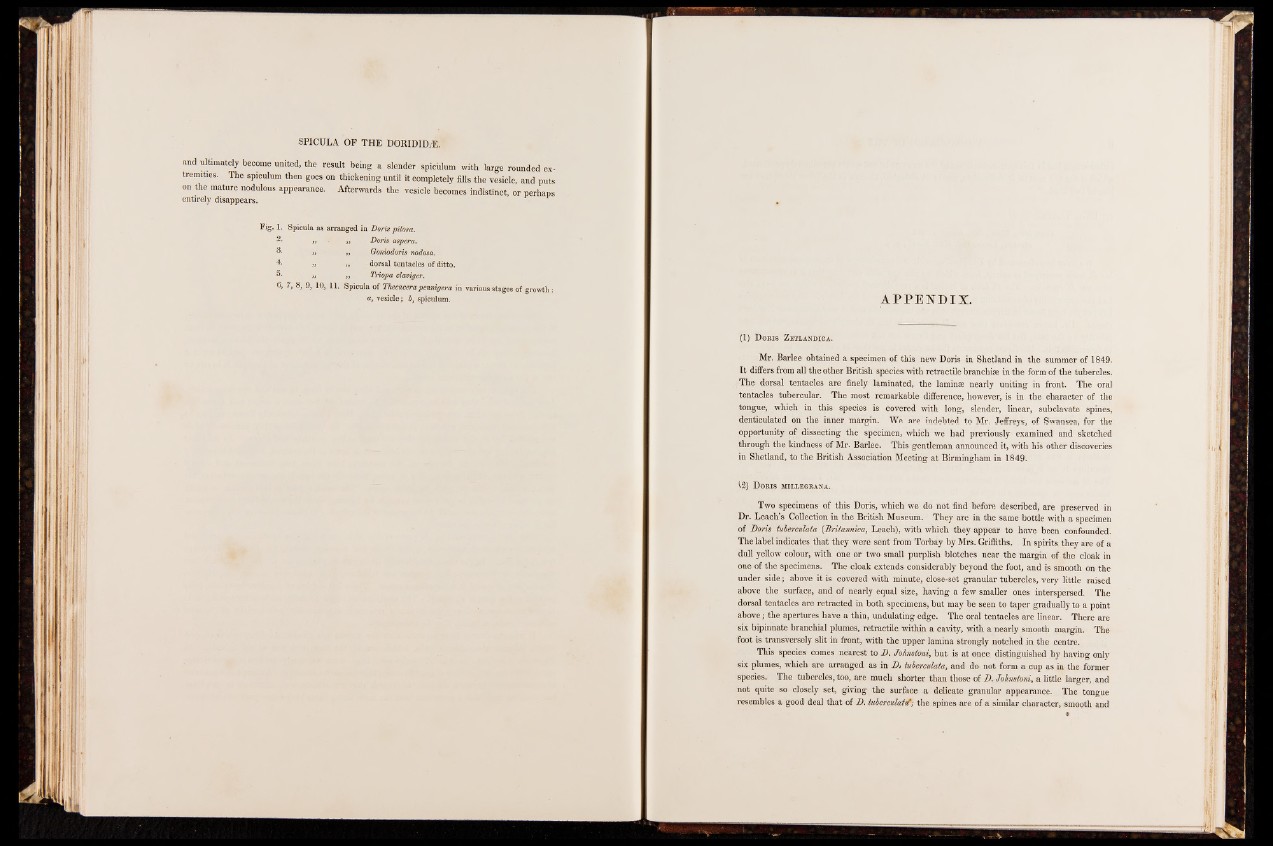
SPICULA OF THE DORIDIDiE.
and ultimately become united, the result being a slender spiculum with large rounded extremities.
The spiculum then goes on thickening until it completely fills the vesicle, and puts
on the mature nodulous appearance. Afterwards the vesicle becomes indistinct, or perhaps
entirely disappears.
Spicula as arranged in Doris pilosa.
« „ Doris aspera.
» „ Goniodoris nodosa.
a „ dorsal tentacles of ditto.
7, 8, 9, 10, 11.
,, Triopa claviger.
Spicula of Thecacera pennigera in various stages of growth:
a, vesicle; b, spiculum. A P P E N D IX .
(1) Doris Zetlandica.
Mr. Barlee obtained a specimen of this new Doris in Shetland in the summer of 1849.
It differs from all the other British species with retractile branchiae in the form of the tubercles.
The dorsal tentacles are finely laminated, the laminae nearly uniting in front. The oral
tentacles tubercular. The most remarkable difference, however, is in the character of the
tongue, which in this species is covered with long, slender, linear, subclavate spines,
denticulated on the inner margin. We are indebted to Mr. Jeffreys, of Swansea, for the
opportunity of dissecting the specimen, which we had previously examined and sketched
through the kindness of Mr. Barlee. This gentleman announced it, with his other discoveries
in Shetland, to the British Association Meeting at Birmingham in 1849.
v2) Doris millegrana.
Two specimens of this Doris, which we do not find before described, are preserved in
Dr. Leach’s Collection in the British Museum. They are in the same bottle with a specimen
of Doris tuberculata {Britannica, Leach), with which they appear to have been confounded.
The label indicates that they were sent from Torbay by Mrs. Griffiths. In spirits they are of a
dull yellow colour, with one or two small purplish blotches near the margin of the cloak in
one of the specimens. The cloak extends considerably beyond the foot, and is smooth on the
under side; above it is covered with minute, close-set granular tubercles, very little raised
above the surface, and of nearly equal size, having a few smaller ones interspersed. The
dorsal tentacles are retracted in both specimens, but may be seen to taper gradually to a point
above; the apertures have a thin, undulating edge. The oral tentacles are linear. There are
six bipinnate branchial plumes, retractile within a cavity, with a nearly smooth margin. The
foot is transversely slit in front, with the upper lamina strongly notched in the centre.
This species comes nearest to D. Johnstoni, but is at once distinguished by having only
six plumes, which are arranged as in D> tuberculata, and do not form a cup as in the former
species. The tubercles, too, are much shorter than those of D. Johnstoni, a little larger, and
not quite so closely set, giving the surface a delicate granular appearance. The tongue
resembles a good deal that of D. tuberculata; the spines are of a similar character, smooth and